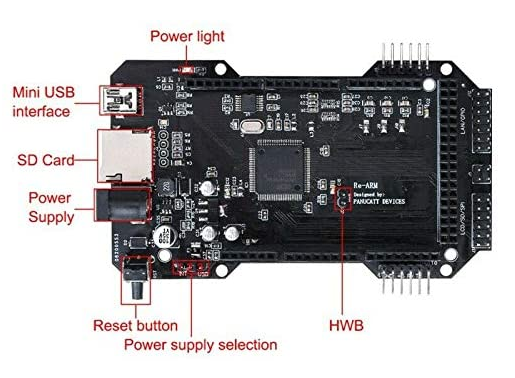If you’re currently using a RAMPS setup with the 8-bit Arduino Mega and you’re feeling limited by the slowness of the 8 bit processor, you might like to switch to the Re-Arm 32 bit micro controller board.

Re-ARM Controller 32 Bit Overview
The Re-ARM board is a 32 bit plug-in replacement for the Arduino Mega which only has an 8 bit processor developed by Panucatt Devices. The Re-Arm also runs at 100Mhz which is much faster than the Mega which only runs at 16Mhz.
It uses the popular NXP Arm® Cortex-M3 processor – LPC1768.

This board is compatible with Marlin, Smoothieware and possibly other popular 3D Printer Firmware. Re-Arm Controller is easy to configure and widely discussed on 3D Printer forums.
Re-ARM Controller Stepper Driver Compatibility
The Re-Arm is compatible with all stepper drivers that currently work with the RAMPS and Mega setup. However, with this board you can increase the step rates and try smaller micro step settings.
Checkout out our article comparing Stepper Drivers and they are all compatible with this board. Stepper Driver Comparison 3D Printer Upgrade
Wiring Connection
The board has the capacity to connect 1 heated bed and 2 Hotend Mosfet drivers for your extruder fans. You can also connect 6 end stops and 3 thermistors. You can use the Epcos 100k thermistors and configure them using Marlin or Smoothieware.
All the GPIO pins are 5 volt tolerant, however, the analog pins are only 3.3 volt tolerant. Make sure that you’re aware of this because if you plug 5 volts into the analog pins, you’re likely to fry the board.
Here is a great starter set for common 3D Printer connectors and crimping tool.

Ethernet Compatibility
You can use an Ethernet add-on board to enable the use of Smoothieware’s built in web control.
USB and SD Card Compatibility
The Re-Arm has an onboard Micro-SD slot and a Mini USB Port for Octoprint or External Connection.
Re-ARM Controller Displays Compatibility
The Re-Arm is compatible with SPI Displays like the most common RepRap Discount display, TFT Displays or other compatible displays.
Benefits Of Using the Re-ARM Controller
So, what are the benefits of upgrading to this board?
- Faster and more powerful 32-bit processor
- Runs on open source firmware (Smoothieware & Marlin)
- Easy to configure using the on-board SD card or Micro USB Port
- You can run smaller micro-step stepper drivers including 1/128 drivers
- 5 volt tolerant GPIO pins. The analog pins are 3.3 volt tolerant
- Can support 6 end stops and 3 thermistor inputs
- Supports LCD & TFT displays
Who Is This Board Ideal For?
You might be wondering if the Re-Arm is what you need. Here’s a rundown of who would benefit from installing this board.
- Anyone who has an existing RAMPS setup and wants the power of a 32 bit processor.
- Enthusiasts who have multiple printers but are on a budget. You can easily swap out the board to whichever machine you want to use due to its plug-in capability.
- If you just want to test whether using a 32 bit processor will help with your printing capabilities, then this board is good value.
- Anyone who loves to tinker, invent or code will benefit from getting this board.
Summary
The Re-Arm 32 bit Micro Controller Board is great value if you want to upgrade to a faster processor, especially if you currently have a complete RAMPS setup and you’re using the slower 8 bit Arduino Mega board.




